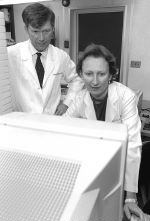|
The history of AIDS (Acquired Immunodeficiency Syndrome), with timelines, photos, and links to resources on the Internet. Endeavoring to raise public awareness through understanding.
|
|
<< History of AIDS last
page || History of AIDS next page >> 1999: Origin of HIV-1 Discovered To place any conspiracy theory into perspective, consider the following media release from scientists at the University of Alabama at Birmingham, titled "Origin of HIV-1 Discovered" (posted on January 31, 1999 at 1:52 p.m.): BIRMINGHAM, AL — Scientists at the University of Alabama at Birmingham (UAB) have discovered the origin of Human Immunodeficiency Virus Type 1 (HIV-1), the virus that causes AIDS in humans. This finding by an international team of scientists led by Dr. Beatrice H. Hahn of
Hahn, a professor of medicine and microbiology at UAB, is senior author of the paper. Dr. Feng Gao, research assistant professor of medicine at UAB, is the paper's lead author. The researchers identified a subspecies of chimpanzee (Pan troglodytes troglodytes) native to West-Central Africa as the natural reservoir for HIV-1. "We have long suspected a virus from African primates to be the cause of human AIDS, but exactly which animal species was responsible was unknown," says Gao. Viruses related to HIV-1 had previously been found in chimpanzees and were given the designation SIVcpz (for Simian Immunodeficiency Virus). However, only three such infected animals were identified, and one of these harbored a virus so different from HIV-1 that most scientists questioned a direct relationship to the human virus. The recent breakthrough came when Hahn and her colleagues identified a fourth SIVcpz infected chimpanzee and used sophisticated molecular techniques to analyze all four viruses and the animals from which they were derived. The researchers found that three of the four SIVcpz strains came from chimpanzees that belonged to one particular subspecies, termed Pan troglodytes troglodytes, which is native to West-Central Africa. The fourth virus strain, which was genetically divergent from the other three, came from an animal that belonged to a different chimpanzee subspecies, termed Pan troglodytes schweinfurthi, which is native to East Africa. The scientists then discovered that all known strains of HIV-1, including the major group M (responsible for the global AIDS epidemic) as well as groups N and O (found only in West-Central Africa), were closely related only to SIVcpz strains infecting Pan troglodytes troglodytes. The final piece of the puzzle was put in place when the researchers realized that the natural habitat for Pan troglodytes troglodytes overlaps precisely with the region in West-Central Africa where all three groups of HIV-1(M, N, and O) were first recognized. Based on these findings, Hahn and her colleagues concluded that Pan troglodytes troglodytes is the origin of HIV-1 and has been the source of at least three independent cross-species transmission events of SIVcpz. While the origin of the AIDS epidemic has been clarified, an explanation for why the epidemic arose in the mid-20th century, and not before, remains a matter of speculation. "Chimpanzees are frequently hunted for food, especially in West-Central Africa, and we believe that HIV-1 was introduced into the human population through exposure to blood during hunting and field dressing of these animals," says Hahn. She further believes that while incidental transmissions of chimpanzee viruses to humans may have occurred throughout history, it was the socio-economic changes in post-World War II Africa that provided the particular circumstances leading to the spread of HIV-1 and the development of the AIDS epidemic. "Increasing urbanization, breakdown of traditional lifestyles, population movements, civil unrest, and sexual promiscuity are all known to increase the rates of sexually transmitted diseases and thus likely triggered the AIDS pandemic," adds Hahn. "The importance of the current findings could be far reaching," says Dr. George Shaw, a Howard Hughes Medical Institute Investigator at UAB and a principal author of the paper. "Chimpanzees are identical to humans in over 98 percent of their genome, or hereditary material, yet they appear to be resistant to the damaging effects of the AIDS virus on the immune system. By studying the biological reasons for this difference, we may be able to obtain important clues concerning the pathogenic basis of HIV-1 in humans and possibly new strategies for treating the disease more effectively." He further added that a better understanding of exactly how the chimpanzee's immune system responds to SIVcpz infection compared to that of humans is likely to lead to the development of more effective strategies for an HIV-1 vaccine. Finally, the authors of the paper note that transmission of SIVcpz could still be ongoing. "The bushmeat trade — the hunting and killing of chimpanzees and other endangered animals for human consumption — is a common practice in West-Central Africa and represents an ongoing risk for humans," says Hahn. "Subsistency hunting has always been a part of West-Central African culture, but increasing logging activities in the past decade have provided unprecedented access to remote forest regions and have led to the commercialized killing of thousands of chimpanzees, gorillas, and monkeys. It took us 20 years to find where HIV-1 came from, only to realize that the very animal species that harbors it is at the brink of extinction," says Hahn. "We cannot afford to lose these animals, either from an animal conservation or a medical investigative standpoint," she says. "It is quite possible that the chimpanzee, which has served as the source of HIV-1, also holds the clues to its successful control." Hahn and her colleagues hope that as a consequence of their research, there will be additional measures taken to discourage chimpanzee poaching and to preserve this and other endangered primate species. The team of scientists responsible for the AIDS discovery included UAB's Ya-Lu Chen, Cynthia Rodenburg and Scott Michael as well as Paul Sharp and Elizabeth Bailes from the University of Nottingham in England; David Robertson from the Laboratory of Structural and Genetic Information in Marseilles, France; Larry Cummins from the Southwest Foundation for Biomedical Research in Texas; Larry Arthur from the Frederick Cancer Research and Development Center in Frederick, Maryland; and Martine Peeters from the Laboratory of Retroviruses at ORSTOM in Montpellier, France. The research was funded by the National Institute of Allergy and Infectious Diseases and the Howard Hughes Medical Institute. Source: UAB Media Relations
The History of AIDS © 2005 |

